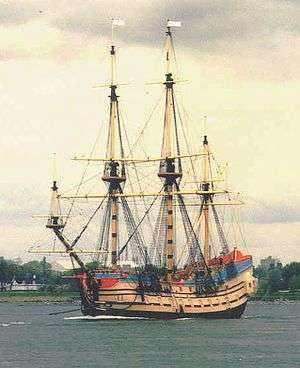French ship Pélican (1693)
 Replica of Le Pélican | |
| History | |
|---|---|
| Name: | Pélican |
| Builder: | Félix Arnaud, Bayonne |
| Laid down: | April 1692 |
| Launched: | early 1693 |
| Commissioned: | May 1693 |
| Fate: | Sank after the Battle of Hudson's Bay 1697 |
| General characteristics | |
| Class and type: | Ship of the line (Vaisseau du troisième rang) |
| Tons burthen: | 500 tons |
| Length: | 118 feet (36 m) |
| Beam: | 32.5-foot (9.9 m) |
| Depth of hold: | 12.5-foot (3.8 m) |
| Sail plan: | Three masts |
| Armament: | 50 cannons, comprising 22 x 12pdrs, 20 x 8pdrs and 8 x 4pdrs |
The Pélican was a French warship from the late 17th century. Built in Bayonne, France, the original Pélican was launched in 1693. A 500-ton ship fitted with 50 guns and commanded by Captain Pierre Le Moyne d'Iberville, she ran aground on the shores of Hudson Bay a few days after an heroic battle in 1697, badly damaged by the encounter and by a fierce storm. In five short months the ship's place in history had been assured, as the victor in the greatest naval battle in the history of New France.
Upon learning that the English were planning to maintain control of Hudson Bay, French King Louis XIV assembled a fleet of warships, consisting of the Pélican, the Palmier, the Wesp, and the Profond. The goal was to recapture Fort Bourbon, as the French called York Factory, Manitoba, the heart of the fur trade.

Pélican set sail from France on 8 April 1697. On the morning of 5 September 1697 in present-day Canada, temporarily separated from her sister ships, she came face to face with three English ships – the Hampshire, the Dering, and the Hudson Bay – which were carrying supplies to the nearby fort. Although they were outnumbered, the crew of the Pélican engaged in battle and triumphed. The ship, however, was fatally damaged in the battle. With holes below the waterline, Pélican had to be abandoned; it was run aground on 8 September.
The Pélican's victory, later known as Battle of Hudson's Bay, was certainly due in large part to the leadership of Captain Pierre Le Moyne d'Iberville. In addition to setting an example of courage and valour for his crew, he fought a remarkable strategic battle – with the result that the Hampshire sank, the Dering retreated, and the Hudson Bay was captured complete with its cargo.
Le Pélican (1992)
Three centuries later, an authentic replica of the Pelican was built in La Malbaie, Quebec. Construction began in 1987, but the project encountered many problems. In 1991, the architect François Cordeau was removed from the project management. The concept was then changed quite a bit. The wooden hull gave way to steel, up to the waterline. AML Naval Shipyard remade the ship's bottom. All sorts of other important changes reinforced the vessel. The ship was completed in 1992.[1]
For two years, the Pelican II was in the Old Port of Montreal as a museum, and it was finally sold to a Louisiana company in 1995. The purchase of the Pelican by a company in Louisiana marked more than the beginning of a symbol of New France abroad. It also sealed an end on Quebec soil, of a true epic after seven years of construction in which $15 million dollars were spent, and the famous ship was never able to sail.[2]

The ship was placed in the port of New Orleans from 1995 to 2002. It was then moved to Donaldsonville, Louisiana, farther up the Mississippi River, where it became the property of the Fort Butler Foundation. It sank once in 2002 and was refloated. It was struck by a tugboat in 2004, and the city decided not to raise the ship. On 19 January 2008, a barge towboat struck Pélican II again. Fuel leaking from the towboat caused the river to be closed to boat traffic.[3]
Half of the hull of the ship was made of metal, so that lifting her out of the water became a problem. Today not much is left of the ship except for a marker.
Photos during construction
- The Pelican under construction in 1990
- The Pelican under construction in 1991
- The Pelican under construction in 1992
 The Pelican in the port of Montréal in 1993
The Pelican in the port of Montréal in 1993
References
| Wikimedia Commons has media related to Pélican (ship, 1693). |
- ↑ name=USAToday USA Today
- ↑ La Presse, La Presse
- ↑ "Barge hits sunken warship replica in La.". USA Today. 20 January 2008. Retrieved 2008-06-09.